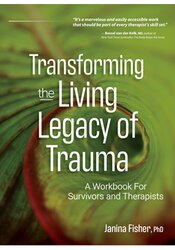Desperate Efforts to Regulate a Traumatized Nervous System
Understanding the Vicious Circle of Addictive and Self-Destructive Behavior

Any addictive or self-destructive behavior begins as a survival strategy: as a way to numb, wall off intrusive memories, self-soothe, increase hypervigilance, combat depression, or facilitate dissociating. But compulsive behaviors also have a “drug effect” that wears off after a few minutes or hours, increasing the sense of urgency to repeat the action or to take more of the substance to prevent losing that positive effect. With repeated use, the body develops tolerance, meaning that these psychoactive substances (whether alcohol, heroin, or the body’s own chemicals like adrenaline) require continual increases in dosage to maintain the original degree of relief and eventually are needed just to ward off physical and emotional withdrawal effects.
Were it not for the body’s increasing tolerance, trauma survivors could use these means of obtaining relief in a moderate, low-risk way for years. Instead, over time, eating disorders become increasingly worse, substance use becomes abuse, self-harm becomes more dangerous, and suicidal thoughts and wishes become more actively life-threatening. Thus, the substance use or self-destructive behavior may begin as an effective approach to managing post-traumatic reactions, but then it gradually acquires a life of its own, becoming increasingly disruptive to the survivor’s functioning until it is a greater threat than the symptoms it attempts to keep at bay.
Once the thinking brain matures in our 20s, we have more capacity to appreciate the consequences of unsafe behavior and more ability to think before we act, but that increased awareness often results in shame: “Why am I doing this? If anyone knew, they would judge me. I need to stop, but I can’t!” Survivors may hate themselves for using these ways of coping, but the alternative is worse. The emotions and implicit memories that were dangerous to feel or acknowledge long ago still trigger the same sense of threat—and the same desperate need to stop them at all cost.
Without understanding the method to their madness, the logical conclusion most trauma survivors reach is: “There must be something wrong with me—I must be defective.” Their shame and self-blame of course trigger more intense, intolerable feelings—further increasing the need to do something to make the feelings stop. They are now literally, as the saying goes, “between a rock and a hard place.” If they stop the behaviors that stem the tide of overwhelming feelings, then the feelings will be even more intolerable. If they do not stop, the shame worsens into self-hatred. Few trauma survivors realize that their self-destructive behavior represents an ingenious attempt to regulate their nervous systems and their unbearable physical and emotional reactions.
Use the following to explore how you have learned to regulate yourself. How do you try to manage your nervous system and distressing emotions? What is your “go-to” way of feeling better? Your second most familiar way of trying to manage traumatic activation? Do not judge yourself—just be curious about how these behaviors help! Whatever you notice will not only help you understand your actions and reactions as ways you are trying to help yourself, but it will also tell you more about how you survived. Was survival dependent upon staying frightened and on guard? Ashamed and people-pleasing? Or shut down and numb? Or being constantly on the run?
When you are a trauma survivor who has learned to manage overwhelming feelings using addictive, eating-disordered, or unsafe behavior, it takes more than this book alone to address both the trauma and the ways you are coping with it. This way of thinking about how you have learned to survive and adapt, however, is an important first step.
For more information on how to understand and increase awareness of these nervous system reactions—and to heal from trauma—.
______
*This is an adapted excerpt from Transforming the Living Legacy of Trauma by Janina Fisher. Copyright ¬© 2021, Janina Fisher. ∞≈¿÷ ”∆µ Publishing & Media.
Were it not for the body’s increasing tolerance, trauma survivors could use these means of obtaining relief in a moderate, low-risk way for years. Instead, over time, eating disorders become increasingly worse, substance use becomes abuse, self-harm becomes more dangerous, and suicidal thoughts and wishes become more actively life-threatening. Thus, the substance use or self-destructive behavior may begin as an effective approach to managing post-traumatic reactions, but then it gradually acquires a life of its own, becoming increasingly disruptive to the survivor’s functioning until it is a greater threat than the symptoms it attempts to keep at bay.
Once the thinking brain matures in our 20s, we have more capacity to appreciate the consequences of unsafe behavior and more ability to think before we act, but that increased awareness often results in shame: “Why am I doing this? If anyone knew, they would judge me. I need to stop, but I can’t!” Survivors may hate themselves for using these ways of coping, but the alternative is worse. The emotions and implicit memories that were dangerous to feel or acknowledge long ago still trigger the same sense of threat—and the same desperate need to stop them at all cost.
Without understanding the method to their madness, the logical conclusion most trauma survivors reach is: “There must be something wrong with me—I must be defective.” Their shame and self-blame of course trigger more intense, intolerable feelings—further increasing the need to do something to make the feelings stop. They are now literally, as the saying goes, “between a rock and a hard place.” If they stop the behaviors that stem the tide of overwhelming feelings, then the feelings will be even more intolerable. If they do not stop, the shame worsens into self-hatred. Few trauma survivors realize that their self-destructive behavior represents an ingenious attempt to regulate their nervous systems and their unbearable physical and emotional reactions.
Use the following to explore how you have learned to regulate yourself. How do you try to manage your nervous system and distressing emotions? What is your “go-to” way of feeling better? Your second most familiar way of trying to manage traumatic activation? Do not judge yourself—just be curious about how these behaviors help! Whatever you notice will not only help you understand your actions and reactions as ways you are trying to help yourself, but it will also tell you more about how you survived. Was survival dependent upon staying frightened and on guard? Ashamed and people-pleasing? Or shut down and numb? Or being constantly on the run?
When you are a trauma survivor who has learned to manage overwhelming feelings using addictive, eating-disordered, or unsafe behavior, it takes more than this book alone to address both the trauma and the ways you are coping with it. This way of thinking about how you have learned to survive and adapt, however, is an important first step.
For more information on how to understand and increase awareness of these nervous system reactions—and to heal from trauma—.
______
*This is an adapted excerpt from Transforming the Living Legacy of Trauma by Janina Fisher. Copyright ¬© 2021, Janina Fisher. ∞≈¿÷ ”∆µ Publishing & Media.
Transform traumatic experiences with this...

Dr. Janina Fisher, international expert on trauma, has spent over 40 years working with survivors, helping them to navigate the healing journey.
In Transforming the Living Legacy of Trauma, Janina shows how the legacy of symptoms helped them survive and offers:
Transforming the Living Legacy of Trauma is a workbook and guide to the journey to healing. As a ‘guidebook,’ it describes the terrain to be explored, and it provides maps to help travelers find the best routes to a life beyond trauma.
In Transforming the Living Legacy of Trauma, Janina shows how the legacy of symptoms helped them survive and offers:
- Step-by-step strategies that can be used on their own or in collaboration with a therapist
- Simple diagrams that make sense of the confusing feelings and physical reactions survivors experience
- Worksheets to practice the skills that bring relief and ultimately healing
Transforming the Living Legacy of Trauma is a workbook and guide to the journey to healing. As a ‘guidebook,’ it describes the terrain to be explored, and it provides maps to help travelers find the best routes to a life beyond trauma.
Meet the Expert:
Janina Fisher, Ph.D., is a licensed clinical psychologist and former instructor at The Trauma Center, a research and treatment center founded by Bessel van der Kolk. Known as an expert on the treatment of trauma, Dr. Fisher has also been treating individuals, couples and families since 1980.
She is past president of the New England Society for the Treatment of Trauma and Dissociation, an EMDR International Association Credit Provider, Assistant Educational Director of the Sensorimotor Psychotherapy Institute, and a former Instructor, Harvard Medical School. Dr. Fisher lectures and teaches nationally and internationally on topics related to the integration of the neurobiological research and newer trauma treatment paradigms into traditional therapeutic modalities.
She is co-author with Pat Ogden of Sensorimotor Psychotherapy: Interventions for Attachment and Trauma (2015) and author of Healing the Fragmented Selves of Trauma Survivors: Overcoming Internal Self-Alienation (2017) and the forthcoming book, Working with the Neurobiological Legacy of Trauma (in press).
Learn more about their educational products, including upcoming live seminars, by clicking here.
She is past president of the New England Society for the Treatment of Trauma and Dissociation, an EMDR International Association Credit Provider, Assistant Educational Director of the Sensorimotor Psychotherapy Institute, and a former Instructor, Harvard Medical School. Dr. Fisher lectures and teaches nationally and internationally on topics related to the integration of the neurobiological research and newer trauma treatment paradigms into traditional therapeutic modalities.
She is co-author with Pat Ogden of Sensorimotor Psychotherapy: Interventions for Attachment and Trauma (2015) and author of Healing the Fragmented Selves of Trauma Survivors: Overcoming Internal Self-Alienation (2017) and the forthcoming book, Working with the Neurobiological Legacy of Trauma (in press).
Learn more about their educational products, including upcoming live seminars, by clicking here.



